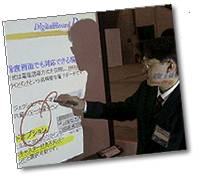|
COMDEX
'99
Is the trade show dead in Japan?
Text and photos by Hugh Ashton
There are certain
smells that evoke memories. Among these smells for me are the smell of hot electronics
(recording studios), printer's ink (working in a book warehouse) and glue and
new paint (trade shows). The last was brought home to me as I descended the escalator
at Makuhari Messe to the first day of Comdex Japan '99, this year held in two
halls in what must be one of the world's most inconvenient exhibition centers.
My memories returned to the times when I helped staff the booth of computer manufacturers
at crowded trade shows at Earl's Court, Olympia, and the NEC (all in the UK),
waiting for the flood of visitors which we would lure into our "Deception Area"
and "Hostility Suite" as these parts of the booth were known, to the dismay of
our marketing manager. Usually, Japanese trade shows have followed this pattern
- crowds, crowds, and more crowds.
This year at Comdex,
there was plenty of space to see the booths. The aisles seemed wider and emptier
than usual, and the cavernous spaces of Makuhari echoed to the sound of mini-skirted,
high-booted "companion girls" reciting the virtues of complex competing software
products at full volume in a Japanese-sexy (i.e. screeching high-pitched) voice
accompanied by wildly inappropriate house or Eurobeat music, to an audience of
gray-suited businessmen.
Hunting for
hardware
I was asked to prowl for hardware, but I found there was time to take in almost
everything worth seeing without too much trouble. My preference is for the small
and cute (if you've met my wife, you'll know what I mean) but there wasn't too
much of that around (we're talking hardware here, you understand). However, I
did see a rather nice little pair of server boxes, preconfigured with Linux (see
photos).
 Web server bundles on the cheap, from Bluegrass http://www.dst.ne.jp/freesever.
Web server bundles on the cheap, from Bluegrass http://www.dst.ne.jp/freesever.
Bundled with two
years' worth of Internet connectivity and a service option, as well as options
for routers, UPS and other necessities for a server, these weighed in at as little
as a mere ¥230,000 or so as a package - a nice easy introduction to Web servers
for a company just starting to make its presence felt on the Internet. Try http://www.dst.ne.jp/freesever
for information on these products.
Also in the small
server category were 1U (1.75" height, if you're unfamiliar with the U measurement
system) rack-mountable servers. Maybe not the fastest machines available, but
certainly suitable for low-volume Web applications, hosted at a server farm with
many other similar devices: http://www.nlights.co.jp
 1U rackmount server. See: http://www.nlights.co.jp.
1U rackmount server. See: http://www.nlights.co.jp.
Cyberspace via
Xybernaut
What else? How about a wearable computer? The Xybernaut series, made in Japan,
and jointly marketed by American and Japanese companies, features a Windows-based
machine with all kinds of interesting portable I/O options, including wireless
networking. While the user/wearer of this device has an alarming tendency to look
like Robocop, there are almost certainly applications for this, and we may report
on this trend in a later issue. http://www.xybernaut.com
Digital meetings
A digital whiteboard projection system, allowing the user to project a computer
screen and then "draw" on it was an impressive feature of the Hitachi stand. "So
what?" you say. "I can project onto a whiteboard any time". The advantage of this
system is that the handwritten annotations can then be written back to the computer
and printed out. In addition, the "pen" also acts as a mouse, allowing a fully
interactive presentation to be made from the whiteboard.
Although this is
not exclusive to Japan, it was the first time I had seen this application in action.
It's not for everyone, but if you need to make presentations and impress your
boss, this is for you (the price tag alone may impress the accountants!). http://mmmeet.hitachi-sk.co.jp
 Digital
whiteboard from Hitachi. Digital
whiteboard from Hitachi.
And from overseas
At the other end of the scale, there were a large number of Korean exhibitors,
selling small parts and add-ons. One thing that struck me was the influence that
the iMac and the new G3/G4 Macintoshes have had on design. No longer are PC users
stuck with beige or off-white boxes. Now, a whole range of translucent and other
non-standard colors and shapes are available to them. Let's hope some of these
ideas permeate into the mainstream (we're seeing inklings of this already).
My personal favorites
in the "silly box" category were a series of animal cases, which turned the features
of a computer (reset and power switches, for example) into features of an animal.
The penguin case here would seem to be ideal for a Linux box
Snagging the
software
And software? Well, there seemed to be little that grabbed my personal attention.
I don't run large SAP databases and I have no need to link my Microsoft SQL server
to a call center, so I wasn't really looking that hard. I did notice a Y2K corner,
with Y2K solutions being widely exhibited (since Japan still has a market for
this stuff on November 9, 1999, I suggest that if you live in Japan you should
stock up now on bottled water, bottled gas, and canned food and hunker down for
the duration).
Converging
Digital broadcasting, in the form of SmarTV, in which Oracle has a stake, was
there, but it appeared to be a presentation full of sound and fury which, while
not actually signifying nothing, appeared to be content-reduced.
One interesting
trend is mobile Internet terminals masquerading as phones (iMode). Lotus was showing
a prototype Notes-to-iMode product - a sure sign that this technology is invading
the everyday life of Japan. http://www.lotus.co.jp
... and overall?
So why was Comdex so disappointing, relative to previous years? Well, it's still
expensive to exhibit there. A friend running a small booth told me the cost (over
¥200,000), which means that you must get a high proportion of serious punters
to recoup your investment (and don't forget that the cost of running a booth at
a trade show runs much, much higher than the cost of the booth space itself).
The main reason
has to be Japan's Web explosion (OK, compared to the US, it's not a bang, but
a whimper). It's now so much easier to get hard information and a working demo
of software off the Web than it is to hike underground to the Makuhari line in
Tokyo station, endure a packed train ride, and another long hike through the wind-swept
concrete desert of Makuhari, only to be faced with some long-legged girl with
a cute face who doesn't know SNMP from SMAP (a famous Japanese pop group, if you're
outside Japan). Your local computer store is also more likely to carry what you
want (just five years ago in Hamamatsu, a city of 500,000 people, I was unable
to locate a SCSI-1 to SCSI-2 cable - three years later, I could buy 10-BaseT hubs
and cabling at my local discount store!). Is the trade show dead in Japan? Maybe,
on the scale that we have come to know. Do I mind? Yes, I do. The smell of paint
and glue still has the power to move me, and it would be a sentimental loss to
me if this part of the computer business were to disappear.
Hugh Ashton is
contributing editor at CJ Online.
Back
to table of Contents
Comments
or suggestions?
Contact cjmaster@cjmag.co.jp

|

